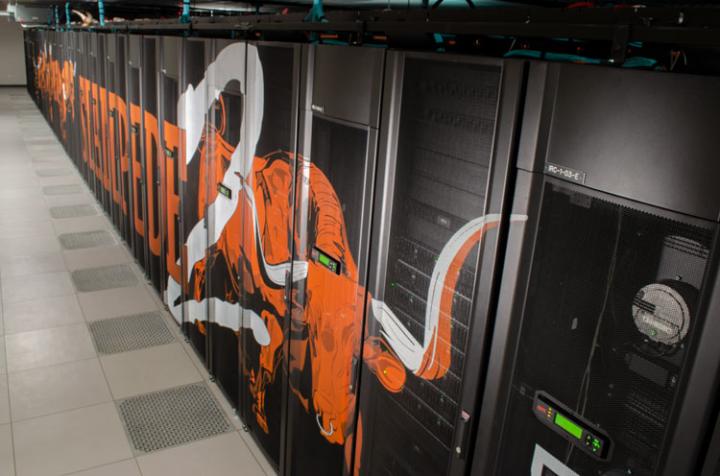Oak Ridge National Laboratory researchers use Stampede2 to refine drug discovery pipeline

Credit: TACC
Since the first known case of COVID-19 in December 2019, the disease has infected over 180 million people and killed nearly four million. A successful group of vaccines that target the coronavirus’s spike protein has started to drive down global infection. Supercomputers are now speeding up the process of finding new potential drug candidates that are safe, effective, and can complement vaccines.
Researchers from Oak Ridge National Laboratory are using the Stampede2 system of the Texas Advanced Computing Center as one of the major compute platforms to help refine the screening of potential drug molecules that can disrupt the spike protein from binding to human cells and causing infection.
The refinement is just one part of a much larger process that casts a wide net at entire databases of millions of compounds that have already passed regulatory approval, such as the ZINC public access database.
The whole process is described as a “supercomputer-driven pipeline for in silico drug discovery,” in research published December of 2020 in the ACS Journal of Chemical Information and Modeling.
A computational prescreening at the beginning of the pipeline process is based on a structural model of the target protein’s atoms.
“We first look at available databases of molecules and check the interactions of the molecules with the proteins. That’s where our effort comes into play,” said drug pipeline study co-author Stephan Irle, leader of the Computational Chemistry and Nanomaterial Sciences Group at Oak Ridge National Laboratory (ORNL). “We use these predictive quantum mechanical methods for the reliable prediction of binding affinity of ligands to the protein.”
In a prior study in pre-preprint at Chemrxiv, Jeremy Smith of ORNL used all-atom molecular dynamics to perform 51,575 docking calculations involving the six conformations of the S-protein:ACE2 interface and 8,669 ligands of the ZINC15 database. The 3000 top potential candidates were sifted out based on binding affinity to the active sites of the coronavirus spike protein.
Those top 3000 were then run through the gamut of quantum mechanics-based ranking refinement and binding analysis — a computationally demanding step that included solvent effects.
The top 100 strongest-binding compounds were validated and further refined using FMO-MP2/PCM single point energy calculations by Irle and colleagues. This created a short list of 47 ligands for further testing, saving precious time by focusing on the most effective inhibitors in an experiment-theory feedback.
The computations were performed on TACC’s Stampede2 supercomputer, taking advantage of the 48 Intel Skylake CPU cores (2 sockets) within one compute node for a single geometry optimization. The Stampede2 supercomputer ranks #35 fastest globally and #3 in U.S. academia, according to the June 2021 Top500 rankings.
“The Stampede2 performance was very high. Also, the service and the support were always very active. We had a very positive experience,” said Van Quan Vuong, Co-PI of the quantum refinement project, study co-author on the drug discovery pipeline project, and a PhD student supervised by Irle at The Bredesen Center for Interdisciplinary Research and Graduate Education, University of Tennessee, Knoxville, TN.
“For one ligand and protein complex, we can get the binding energy (on Stampede2) in only one or two hours,” Irle added. “If we have another computer node, we can get the scoring function of a few hundred compound complexes in a day. That’s a pretty remarkable improvement over traditional DFT calculations.”
The more recent work with the drug discovery pipeline was led by Jeremy Smith of ORNL. The lion’s share of the computation involved molecular dynamics simulations on the ORNL Summit IBM GPU-based system, the #2 fastest supercomputer in the world according to the June 2021 Top500 rankings. It performed about 2.07 million physical docking calculations on a smaller database and 2.4 billion docking calculations with the Enamine REAL database of compounds.
The quantum mechanical refinement protocol developed by Irle and Vuong using Stampede2 is still in its preliminary stages. The researchers plan to investigate 15 spike protein clusters and refine the binding energies of 150 protein ligand complexes in the pipeline study.
Said Irle: “Reducing the number of drug candidates and reliably narrowing down the most active species, eventually will result in a faster response to suddenly emergent pandemic situations like we had with COVID-19. This is a new approach, in that traditionally the involvement of quantum mechanics in computational drug discovery has been an exotic side field because it was considered too expensive. But with the method we have developed, we are in a position to do full quantum chemical analysis of the whole protein with the ligand in order to get reliable binding energies on the order of hours, rather than days.”
###
This ORNL research project and others studying COVID-19 are supported by the DOE Office of Science’s National Virtual Biotechnology Laboratory with funding provided by the Coronavirus CARES Act.
Funding and support for the drug discovery pipeline work was provided by the Alabama Supercomputer Authority, the National Institutes of Health, a National Science Foundation Graduate Research Fellowship, the Cancer Research Informatics Shared Resource Facility of the University of Kentucky Markey Cancer Center, and the University of Kentucky’s Center for Computational Sciences (CCS) high-performance computing resources. Computer time on Summit and Stampede2 was granted by the HPC Covid-19 Consortium.
Media Contact
Jorge Salazar
[email protected]
Original Source
https:/
Related Journal Article
http://dx.




